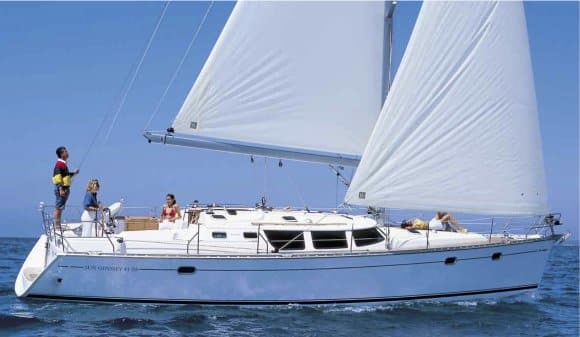
When in the late 1950’s, Henri Jeanneau began building motorboats from the new wonder product called fiberglass-reinforced plastic, he couldn’t have imagined that the company bearing his name would someday have turned out more than 60,000 boats, or 4,000 boats annually. But 45 years and three owners later, Chantiers Jeanneau does exactly that. And while the French yard employs state-of-the-art technology in its production line to handle such capacity, still its boatbuilding techniques remain almost as traditional as they were in Henri’s day.
We sailed the Sun Odyssey 43, Jeanneau’s most recent offering to the U.S. market, in a 15-knot southerly last fall off Annapolis, Maryland, making a pleasurable 6.5 to 7 knots on the wind.
Built of hand-laid fiberglass without a core, the 43 hull, like other Jeanneau sailboats, is stiffened with laminated-wood longitudinal stringers and ring frames and without structural liners. For years, this was a point of difference between Jeanneau and its archrivals at Beneteau, whose boats are engineered with liners. Even after Groupe Beneteau bought Chantiers Jeanneau in 1995, the construction differences (and some of the former rivalry) between Jeanneau and Beneteau remain. Dealers for one line sell against the other; the twain meet only at Groupe Beneteau’s corporate levels.
The Sun Odyssey 43 is designed with families and charter guests in mind. Its ingenious modular interior can be converted by the owner from two cabins to four; removable bulkheads in the forward and aft cabins fit into slots in the overhead. An L-shaped galley and U-shaped dinette, each to starboard, provide ample room for guests and those tending to them, as do two separate heads. Standing headroom in the cabin ranges from 6 feet 2 inches to 6 feet 11 inches.
The cockpit’s been created with a mind toward opening one clear path from the companionway past the helm and over the transom for swimming and dinghy access. Twin helm stations leave the center alley open, and the middle section of the helmseat drops down to clear the way. A midships cockpit table provides a foot brace under sail. One drawback to the cockpit arrangement is that the mainsheet traveler and winch, mounted on the cabin top, can’t be reached from the helm. The boom is quite high—a good thing for noggin clearance, but at the expense of raising the rig’s center of effort. All sailhandling lines from the mast run through stoppers on the cabin top, and their tails drop down the companionway.
The deck is low profile, offering an easy step from side deck to cabin top. The 43’s deck is cored with balsa; it’s joined to the hull’s inward-turning flange with Sikaflex adhesive and self-tapping screws on 8-inch centers.
Powered by a 56-horsepower Yanmar diesel, the 43 made 7 knots at 2,700 rpm; the noise she generated was among the highest of last year’s new-boat fleet, with decibels between 95 and 103 measured in the cabin. Additional insulation in the engine space would dampen that.
In terms of volume for money, the Sun Odyssey 43, at $230,000 sailaway, was among the best values in this year’s fleet of new boat models.
At Chantiers Jeanneau, aside from the company’s construction techniques, over the years very little has stayed the same. With a new building facility and a new flagship on the way—a sleek, 54-foot deck saloon due to be launched this month and in the United States for the Miami boat show in February—tradition and technology have attained a prosperous coexistence.
CW executive editor Tim Murphy directs the magazine’s Boat of the Year program.








